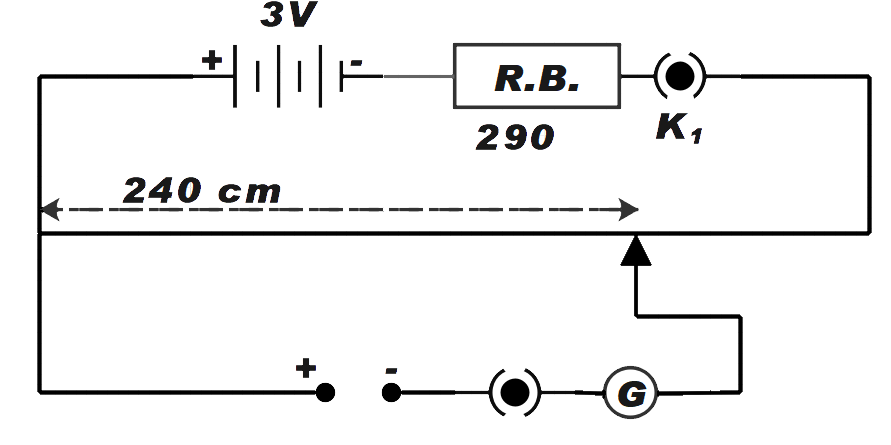
Calculate the value of the unknown potential V for the given potentiometer circuit. The total length (400 cm) of the potentiometer wire has a resistance of 10Ω and the balance point is obtained at a length of 240 cm

A. 0.06 V
B. 0.6 V
C. 6 V
D. None of these

Answer
558.6k+ views
Hint: In this question we have been asked to calculate the unknown potential V for the given potentiometer circuit. Therefore, to solve this question, we shall first discuss what is a potentiometer briefly. We know that for a balanced point in a potentiometer, the ratio of two emf of a battery is equal to the ratio of lengths. Therefore, we shall use this concept to calculate the unknown potential or emf of the battery.
Formula used: \[V=IR\]
Complete step by step solution:
We know that potentiometer is the electrical device used to compare the emfs of two cells. It is also used to calculate the internal resistance of a cell or measure its potential difference. The balance point is obtained in a potentiometer by connecting one of the batteries between the galvanometer. The jockey is moved until the galvanometer shows no deflection. The length of wire is taken as \[{{l}_{1}}\].
The emf of battery is then given as,
\[{{E}_{1}}=\dfrac{{{l}_{1}}}{L}V\] …………….. (2)
Similarly, when second battery is connected, the emf is given by,
\[{{E}_{2}}=\dfrac{{{l}_{2}}}{L}V\] ………… (1)
Therefore, from (1) and (2) we get,
\[\dfrac{{{E}_{1}}}{{{E}_{2}}}=\dfrac{{{l}_{1}}}{{{l}_{2}}}\].
Now, from the diagram, we know that the resistance given is 290 ohms. This resistor is in series with the wire having 10 ohms resistance. Therefore, the total resistance is
\[R=290+10=300\Omega \]
Therefore, using Ohm's law
We get,
\[V=IR\]
Substituting the given values
We get,
\[3=300\times I\]
Therefore,
\[I={{10}^{-2}}A\] …………… (3)
Now, it is also given that the resistance of 400 cm of wire is 10 ohms.
Therefore, resistance of 240 cm length of wire will be,
\[R=240\times \left( \dfrac{10}{400} \right)\]
\[R=6\Omega \] …………………. (4)
Now, substituting (3) and (4) in Ohm's law
We get,
\[{{V}_{0}}={{10}^{-2}}\times 6\]
Therefore,
\[{{V}_{0}}=0.06V\]
Therefore, the correct answer is option A.
Note: A potentiometer is an electrical device with three-terminal resistors with sliding contact that forms an adjustable voltage divider. The potentiometer acts as the rheostat when only two terminals are used. It is a measuring device used to measure the electric potential of the circuit. Potentiometers are commonly used to control electrical devices such as audio control.
Formula used: \[V=IR\]
Complete step by step solution:
We know that potentiometer is the electrical device used to compare the emfs of two cells. It is also used to calculate the internal resistance of a cell or measure its potential difference. The balance point is obtained in a potentiometer by connecting one of the batteries between the galvanometer. The jockey is moved until the galvanometer shows no deflection. The length of wire is taken as \[{{l}_{1}}\].
The emf of battery is then given as,
\[{{E}_{1}}=\dfrac{{{l}_{1}}}{L}V\] …………….. (2)
Similarly, when second battery is connected, the emf is given by,
\[{{E}_{2}}=\dfrac{{{l}_{2}}}{L}V\] ………… (1)
Therefore, from (1) and (2) we get,
\[\dfrac{{{E}_{1}}}{{{E}_{2}}}=\dfrac{{{l}_{1}}}{{{l}_{2}}}\].
Now, from the diagram, we know that the resistance given is 290 ohms. This resistor is in series with the wire having 10 ohms resistance. Therefore, the total resistance is
\[R=290+10=300\Omega \]
Therefore, using Ohm's law
We get,
\[V=IR\]
Substituting the given values
We get,
\[3=300\times I\]
Therefore,
\[I={{10}^{-2}}A\] …………… (3)
Now, it is also given that the resistance of 400 cm of wire is 10 ohms.
Therefore, resistance of 240 cm length of wire will be,
\[R=240\times \left( \dfrac{10}{400} \right)\]
\[R=6\Omega \] …………………. (4)
Now, substituting (3) and (4) in Ohm's law
We get,
\[{{V}_{0}}={{10}^{-2}}\times 6\]
Therefore,
\[{{V}_{0}}=0.06V\]
Therefore, the correct answer is option A.
Note: A potentiometer is an electrical device with three-terminal resistors with sliding contact that forms an adjustable voltage divider. The potentiometer acts as the rheostat when only two terminals are used. It is a measuring device used to measure the electric potential of the circuit. Potentiometers are commonly used to control electrical devices such as audio control.
Recently Updated Pages
A man running at a speed 5 ms is viewed in the side class 12 physics CBSE

The number of solutions in x in 02pi for which sqrt class 12 maths CBSE

State and explain Hardy Weinbergs Principle class 12 biology CBSE

Write any two methods of preparation of phenol Give class 12 chemistry CBSE

Which of the following statements is wrong a Amnion class 12 biology CBSE

Differentiate between action potential and resting class 12 biology CBSE

Trending doubts
What are the major means of transport Explain each class 12 social science CBSE

Which are the Top 10 Largest Countries of the World?

Draw a labelled sketch of the human eye class 12 physics CBSE

How much time does it take to bleed after eating p class 12 biology CBSE

Explain sex determination in humans with line diag class 12 biology CBSE

Explain sex determination in humans with the help of class 12 biology CBSE




